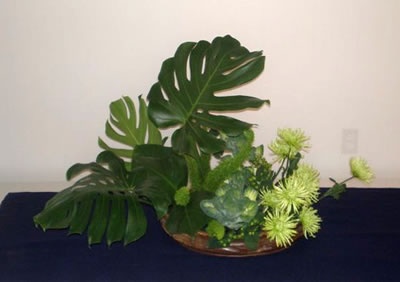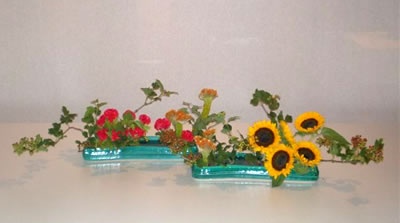Instant intrigue: My encounter with ikebana
On every Friday morning during the summer of 2008 at the Japanese American National Museum, a new work of ikebana is put on display for the special exhibition entitled Living Flowers. It can literally be said that this is a ‘living work of art,’ as opposed to paintings or photography. On one Friday morning in early August, I was able to witness one of these new installments. In one corner of the venue, there was a man drenched in sweat, working on his piece with a marked intensity. That man, now in his 20th year of ikebana experience, was Mr. Jose Salcedo.
Mr. Salcedo first caught a glimpse at ikebana back in February of 1988. The moment he saw an Ikenob? ikebana demonstration at the New Otani Hotel, he instantly thought, “I’ve got to learn this!” He immediately approached the demonstrator with a barrage of inquiries. “It just so happened to be that they were teaching classes near my home in Pasadena. Beginning on the very week that I saw the demonstration, I started learning the Ikenob? style of ikebana.”
Back in high school, Mr. Salcedo had taken a western-style flower arrangement class. “But it was only a one semester class, and since then my life really didn’t have much to do with flowers. Yet, when I saw the Ikenob? demonstration that day, something clicked inside of me.”
Then, in the fall of the same year he was introduced to Ikenob?, he became intrigued with the Ohara style of ikebana. “When I saw an Ohara piece at an exhibition, I felt the same feeling I got when I first saw the Ikenob? work. I felt, ‘I’ve got to learn this.’ It was a piece with a maple leaf floating in water. When I saw it, it brought back visions of a British garden that I saw during a trip I took a few years before then. It was very compelling.”
Eliminating distractions and into another world—standing in front of flowers and a vase
In December of 1988, while still continuing Ikenob?, Mr. Salcedo began studying under the Ohara style. Since then, he has gained licenses as a grand master for both styles, and now teaches Ikenob? and Ohara separately, each once a week. In Japan, one would never be able to teach multiple styles at the same time, but perhaps it is possible here because this is America. Could there be any instances where the two styles get mixed up while teaching?
“The Ohara style puts a strong emphasis on the beautiful nature of Japanese tradition. The Ohara style ikebana allows me to stand face to face with nature. On the other hand, Ikenob? emphasizes attention to the movements of the leaves and branches, and the lines and shapes of the work. When I work with Ikenob?, I’m able to dig deep within myself and see my inner self. So in other words, they are each very different from one another, but they are also styles of ikebana that are both very necessary for me. If they ever become mixed up, I think it would be time for me to give up studying both styles and choose one or the other.”
During the day, Mr. Salcedo works as a software engineer. It is, indeed, a busy profession, so there’s no question that it must have been difficult to continue learning both styles of ikebana on top of all of his work.
“Yes, in fact, on the days that we have ikebana class, I’d go to the flower market at 4:30 in the morning, get the flowers, go home and throw them into to a bucket of water, and rush to get to work. I’d start preparing for class as soon as I got home. No matter how tired I was from work, if there were flowers and a vase in front of me, I could immediately teleport to a different world, away from everyday life. It rids me of all distractions, and I’m able to relax. You’ve probably heard of the saying, “stop and smell the roses”—I think I’m definitely living that philosophy through ikebana.
Some grand masters say that they talk to the flowers while arranging them, so I asked Mr. Salcedo if he does so as well.
“Instead of talking to them, I’d say that I carefully listen to them. When I adjust their placement [in the flower arrangement], I can hear the flowers telling me, ‘yes, this is where I belong.’ On the other hand, if it’s placed somewhere that it doesn’t belong, I feel that I can hear them letting out a small cry.”
There’s a lot to learn from the strict seminars in Japan
In order to learn and keep up with the newest information and styles of ikebana, Mr. Salcedo does not miss a chance to participate in seminars in Japan. He says there is much more to learn from in these seminars, rather than from participating in workshops wherein instructors are dispatched from Japan.
“When instructors come from Japan… maybe it’s because we tend to identify them as our guests… but I feel that they are a bit too nice to us when they teach. But if we’re the ones going to Japan to study, we’re able to receive really strict, full-fledged instructions. I think there’s much more that we stand to gain from being taught rigorously. I’m actually very excited about my next trip to Japan, which is coming up shortly.”
Mr. Salcedo himself is very excited about the seminar in Japan, but he says none of his students have yet to participate.
“One of my goals it to go to Japan with a student of mine. Also, I want to be able to host my own demonstrations and workshops soon. In order to do that, I need to keep working hard and improving.”
A soul with a spirit that seems more ‘Japanese’ than most Japanese people, I asked Mr. Salcedo if anything had changed inside of him before and after beginning ikebana. He answered, “Before, standing before a flower, I never stared closely at or paid any attention to the minute details of the flower. But now, as if to wrap the life of each flower with love, I take a deep, careful look at each and every one the flowers.”
An interesting point is that, of his 12 students studying the Ohara-style, there are three whom are Japanese. An art form that originated in Japan, then passed onto an American like Mr. Salcedo, is now being taught back to Japanese people—perhaps this can be considered proof of the globalization of ikebana.
Profile: In 1988, when turning 28, was exposed to Ikenob?, then the Ohara style, and started ikebana in both styles. He received licenses in both styles, and currently teaches classes for both styles, each once a week. Salcedo works during the day as a software engineer and resides in Pasadena.
© 2008 Keiko Fukuda








